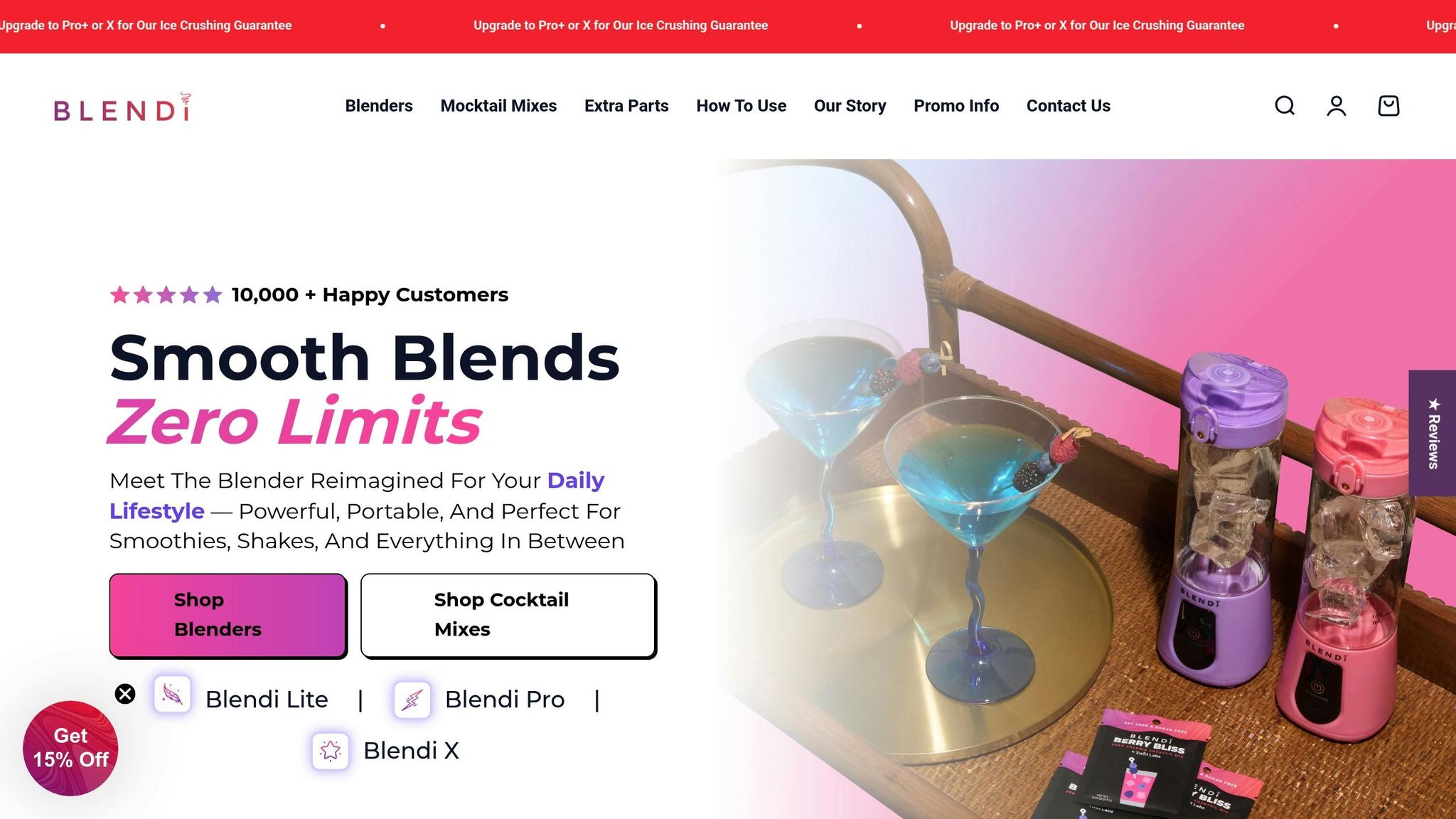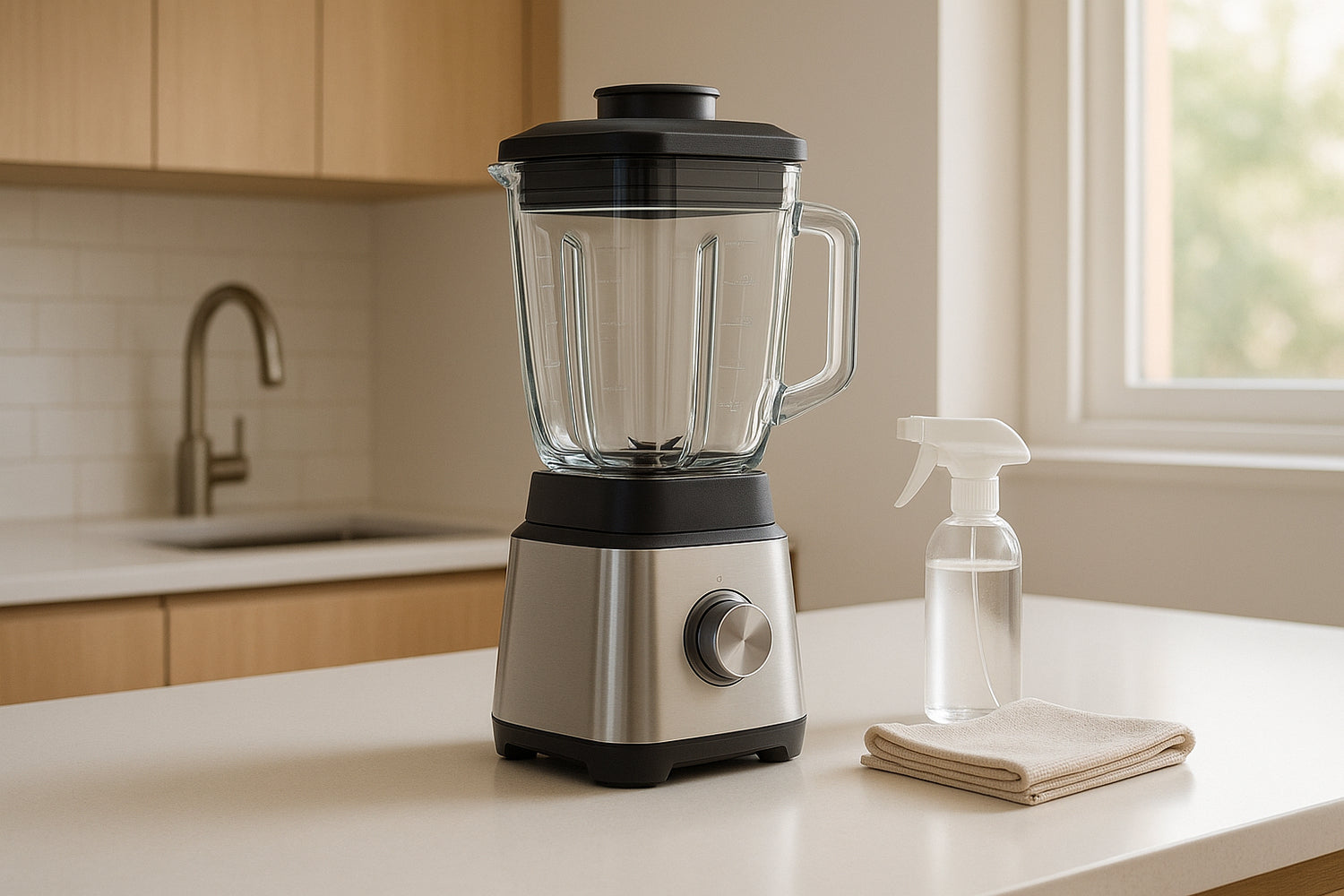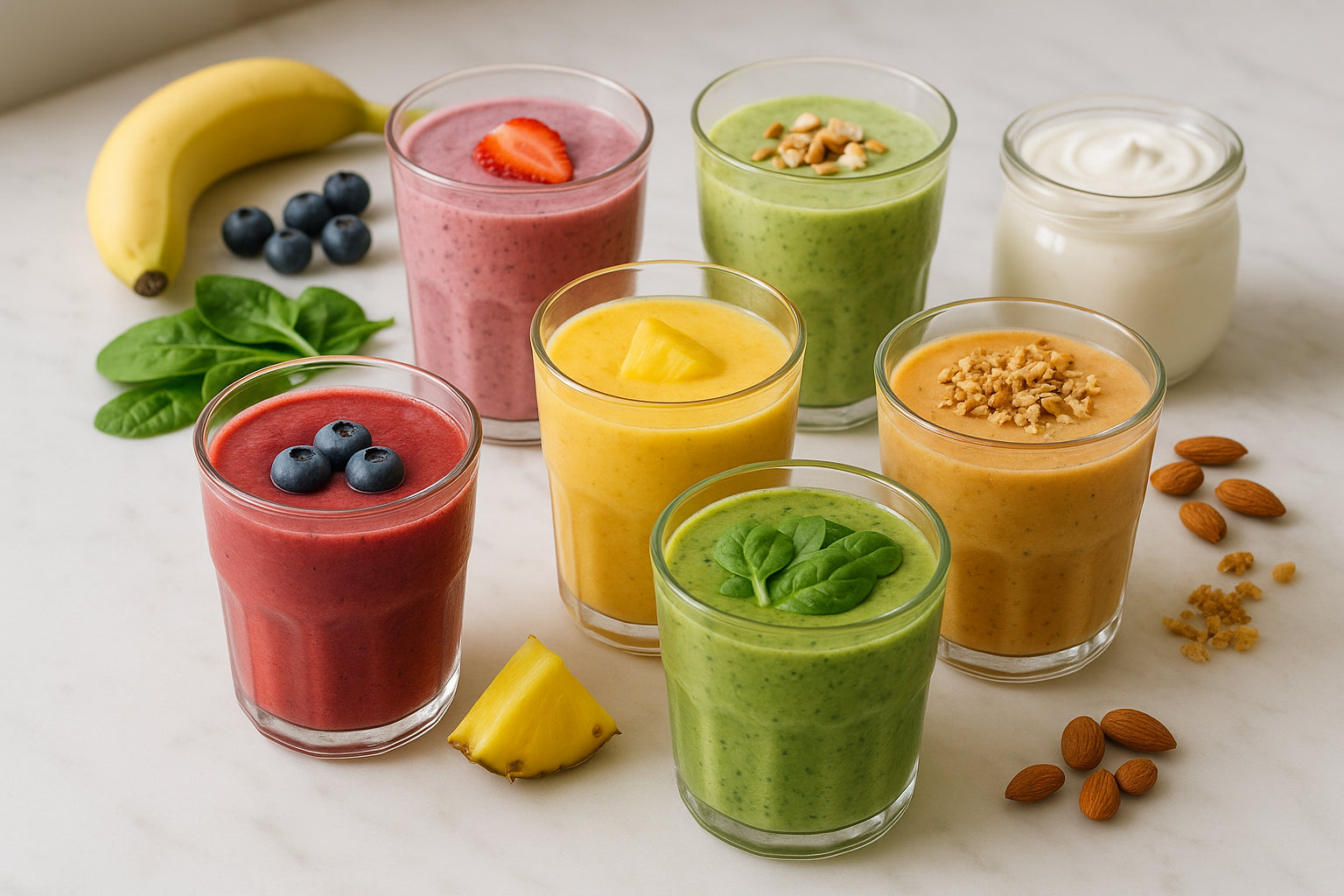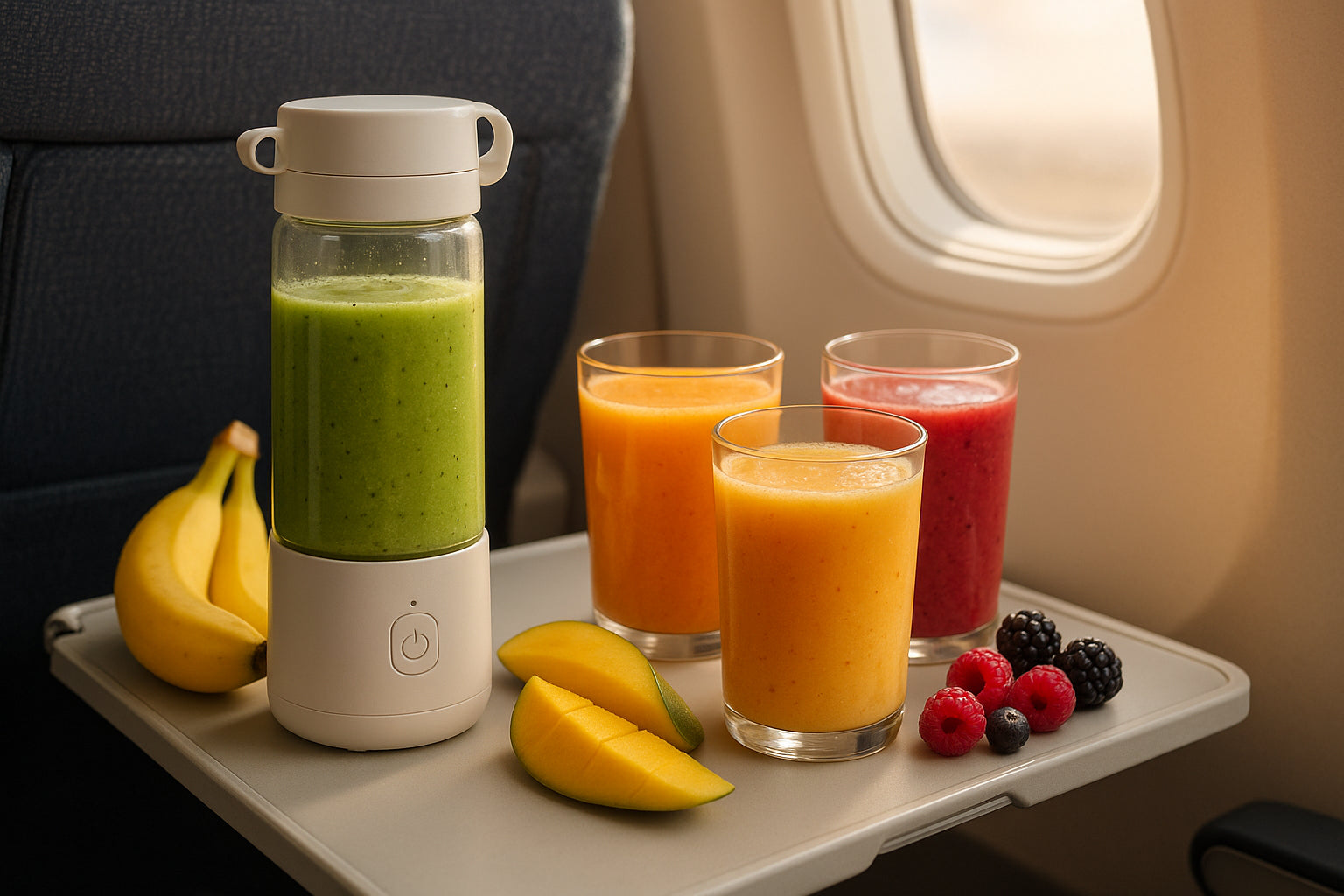Your blender works hard year-round, so proper care is key to keeping it functional and long-lasting. Here's what you need to know:
- Daily Cleaning: Rinse with warm soapy water after each use to prevent buildup.
- Weekly Maintenance: Disassemble and deep clean parts, focusing on blades and seals.
- Battery Health for Portable Models: Recharge at 20–30%, unplug when full, and store at 50–60% charge for extended periods.
- Seasonal Adjustments: Inspect seals in spring, avoid overheating in summer, clean thoroughly in fall, and store properly in winter.
- Troubleshooting: Check battery levels, ensure proper assembly, and clean charging ports to fix common issues.
The Ultimate Ninja Blender Cleaning & Maintenance Guide
Daily and Weekly Maintenance Practices
Keeping your blender in great shape doesn’t have to be complicated. A consistent cleaning routine can do wonders for its performance and longevity. These simple practices work hand-in-hand with the seasonal care tips we’ll touch on later.
Quick Cleaning After Every Use
After each use, a quick cleaning routine is all you need. Just add 2-3 drops of dish soap to a jar half-filled with warm water. Secure the lid, and let the blender run for 30-60 seconds. This simple step cleans the blades and surfaces effectively.
Once the self-cleaning cycle is done, pour out the soapy water and rinse the jar thoroughly with clean water. To ensure there’s no soap residue left, give the jar a quick shake with fresh water before letting it air dry completely. This keeps your blender ready for action whenever you need it.
For deeper cleaning, set aside time once a week. Disassemble the removable parts, such as the blade assembly and gaskets, and soak them in warm, soapy water for 10-15 minutes. Use a soft brush to scrub around the blade base and remove any buildup.
If there are stubborn stains or odors, try a baking soda paste. Mix baking soda with water, apply it to the affected areas, and let it sit for about 5 minutes. Then scrub gently and rinse thoroughly. This method works wonders for removing tough protein residues.
Battery Care for BLENDi Portable Blenders

If you’re using a BLENDi portable blender, taking care of the battery is just as important as cleaning the mechanical parts. To keep the battery in good shape, recharge it when the level drops to around 20-30%, and unplug it as soon as it’s fully charged. Most BLENDi models take about 2-3 hours to charge, making it easy to fit into your daily schedule.
Temperature control is key for battery health. Store your blender in a cool, dry spot, away from direct sunlight or heat sources like stoves or radiators. Extreme temperatures, whether too hot or too cold, can harm lithium-ion batteries and reduce their efficiency.
If you’re planning to store your blender for an extended period, charge the battery to about 50-60% before putting it away. This charge level prevents deep discharge while avoiding the stress of storing it fully charged for months.
Safe Handling of Electronic Components
Protecting the electronic parts of your blender is essential for ensuring its long-term durability. Always keep the motor base and charging components dry during cleaning. Focus water and soap only on the jar and removable parts.
Never submerge the motor base or place it in the dishwasher. Even if the blending jar on some models is labeled dishwasher-safe, hand washing is the gentler option and helps preserve seals and extend the life of the components.
The charging port also needs special care. Wipe it occasionally with a dry cloth to keep it clean and dry. If you notice debris in the port, use a dry toothbrush to gently remove it. Avoid using compressed air, as it can push moisture deeper into the electronics.
Finally, take a moment to inspect the power cord regularly. Look for signs of wear, fraying, or damage. A damaged cord can pose safety risks and affect charging efficiency. If you spot any issues, reach out to customer service rather than attempting repairs yourself. BLENDi’s 1-year warranty covers manufacturing defects, so let them handle it for you.
Seasonal Maintenance Guidelines
Each season brings its own set of challenges for keeping your blender in peak condition. Following these tips will help ensure your BLENDi blender stays reliable year-round.
Spring: Refresh and Reset
Spring is the ideal time to give your blender a detailed check-up, especially after months of winter use or storage. Start by inspecting the seals and gaskets for any signs of wear, like cracks, hardening, or discoloration. If you notice any damage, replace them right away. Cold weather can make these rubber components brittle, and replacing them now will help prevent leaks and maintain proper suction.
Take a moment to clean the charging port on your BLENDi portable blender. Dust or debris can collect there, so gently clean the contacts with a dry cotton swab. This quick step ensures a solid connection when charging and can save you from unnecessary battery issues.
For a deeper clean, soak your blender’s removable parts in warm water mixed with a tablespoon of white vinegar for 15–20 minutes. This helps dissolve any mineral deposits that might have built up from hard water. After soaking, scrub gently with a soft brush, rinse thoroughly, and dry.
Finally, test the blender’s performance by making a simple smoothie. If you notice unusual vibrations or sounds, it could mean the blade assembly needs attention or that internal components have shifted during storage. Once everything checks out, you’re ready to transition into summer use.
Summer: Outdoor Use and Heat Protection
Summer often means outdoor adventures, but the heat and travel can take a toll on your portable blender. Avoid leaving your BLENDi blender in direct sunlight or a hot car, as internal temperatures above 140°F can damage its components. Instead, store and use it in a shaded area whenever possible.
If you’re crushing ice or blending thick summer fruits like mangoes or peaches, give the motor a break between heavy sessions. Waiting 2–3 minutes between uses can prevent overheating and extend the motor’s life.
Sticky residues from sugary fruits or protein powders can be tougher to clean in the heat, so wash your blender immediately after use. This prevents buildup and keeps your blender smelling fresh. If you’re blending outdoors, use the protective case to shield it from sand and debris. If sand does get into the charging port, clean it as described in the spring section.
Fall: Addressing Residue Buildup
Fall’s humidity can create the perfect environment for residue buildup and even bacterial growth if your blender isn’t properly maintained. After cleaning, make sure all parts are completely dry to avoid mold or unpleasant odors.
As the weather cools, smoothies often get thicker with heartier ingredients and more protein. These blends can leave behind stubborn residue, so increase your deep cleaning routine to twice a week. For tough protein buildup, use a baking soda paste to scrub the jar and blades.
If you store your blender in a damp area like a basement or garage, consider moving it to a drier spot. High humidity can lead to corrosion of metal parts and damage electronic components over time.
Pay extra attention to the blade assembly during fall cleaning. Remove it, inspect for food particles caught in the threading or base, and use a small brush or toothpick to remove debris. Dry everything thoroughly before reassembling. These steps will set you up for the more intensive care needed during winter.
Winter: Storage and Battery Care
Winter storage requires a bit of extra care, especially for the battery. If you won’t be using your BLENDi blender for over a month, charge the battery to 50–60% before storing it. This protects the battery from deep discharge or stress caused by long-term full-charge storage.
Store the blender in a temperature-controlled space between 32°F and 85°F. Avoid unheated areas like garages or basements where temperatures could drop below freezing. Extreme cold can damage lithium-ion batteries and make plastic parts brittle.
Before using the blender after winter storage, let it sit at room temperature for 30–60 minutes. This prevents condensation from forming on electronic components. Test the battery performance after storage; if it doesn’t hold a charge as well as before, run 2–3 full charge cycles to help restore it.
Winter’s dry air can also affect rubber seals, causing them to crack or shrink. Inspect the seals monthly and apply a small amount of food-grade silicone lubricant to keep them flexible. This simple step can save you from needing replacements when spring rolls around.
sbb-itb-75eb6cf
Troubleshooting and Extending Blender Life
Even with regular seasonal care, you might still run into minor hiccups with your BLENDi blender. The good news? Most of these issues are easy to fix without needing professional help. Tackling these problems early can help keep your blender running smoothly for years to come.
Common Issues and Simple Solutions
Blender Won't Turn On or Stops Mid-Blend
Start by checking the battery level. If the indicator lights aren’t showing a solid "ready" state (white for Pro+ and Lite models, green for the X model), it’s time for a recharge. Also, double-check that the jar and lid are securely aligned - twist them until the indicator confirms proper placement.
Seeing fast alternating red and blue lights on Pro+ and Lite models, or red lights on the X model? This usually means the blender is overloaded or the blades are jammed. Fix this by cutting ingredients into smaller pieces, filling the cup no more than two-thirds full, and adding extra liquid. A gentle shake can also help dislodge any blockages.
If the blender only runs briefly, it might be due to the empty bottle sensor being activated or the blending cycle finishing. In that case, just restart the unit.
Charging Problems
If your blender isn’t charging, start by inspecting the cable and port connections. Unplug and reconnect everything securely. If that doesn’t work, try using a different USB cable or wall adapter to rule out faulty equipment. To clean the charging port, use a dry, soft brush or a wooden toothpick - avoid metal objects or liquids to prevent damaging the contacts.
Overheating can also interfere with charging. If the blender feels warm, unplug it and let it cool down for 15–30 minutes before trying again. The blender’s built-in safety system won’t allow charging when it’s too hot.
For stubborn charging issues, you can reset the internal system. Just press and hold the power button for 10–15 seconds to clear minor software glitches.
Error Codes and Warning Lights
If you see "ER" or "EL" on the Pro+ and Lite displays, or flashing red lights on the X model, start by checking the battery level and making sure the blender is properly assembled. These codes usually point to one of the common issues mentioned earlier, rather than a major mechanical failure.
If the error persists after checking alignment, charge level, and ingredient load, try resetting the blender. Hold down both the power and start buttons for 10–15 seconds to clear the issue. By addressing these warning signs quickly, you’ll keep your BLENDi blender running at its best all year long.
Product-Specific Care Tips
To keep your BLENDi models running smoothly all year long, it's important to follow these tailored care tips for each product.
Caring for BLENDi Lite, Pro+, and X Models
Each BLENDi model has unique features that require specific handling to ensure optimal performance. Here's how to care for them:
- BLENDi Lite: With its 70W motor and 17oz capacity, this model needs a bit of extra care. Always add liquid before blending and cut fruits or vegetables into smaller pieces. Since it's not designed for crushing ice, handle it gently to avoid straining the motor. When you see "88" on the display, it means the unit is properly assembled and ready to use.
- BLENDi Pro+: This model has a 120W motor and a 17.5oz jar, making it capable of crushing ice. To get the best results, fill the jar no more than two-thirds full. If the motor stops after 5–6 seconds, reduce the load instead of forcing it to blend.
- BLENDi X: With a 24oz capacity and two blending modes, the BLENDi X is built for versatility. For smooth operation, fill it up to 80% with liquid to avoid overflows or error messages. Since the blades are non-removable, take extra care when cleaning this model.
Battery and Cleaning Care
Proper battery and cleaning practices are just as important as handling for keeping your BLENDi in top shape.
- Battery Care: The Lite and Pro+ models require an initial charge of 3–5 hours until the "FL" indicator appears, while the BLENDi X charges until the green light turns on. To protect the battery and internal components, never use your BLENDi while it's charging.
- Cleaning Tips: Avoid putting any BLENDi parts in the dishwasher, as high heat can damage the plastics. After washing, turn the blender upside down to let it air dry. Although the USB port is waterproof, avoid soaking the motor base to prevent damage.
Model Comparison Table
| Feature | BLENDi Lite | BLENDi Pro+ | BLENDi X |
|---|---|---|---|
| Capacity | 17oz | 17.5oz | 24oz |
| Motor Power | 70W | 120W | 150W |
| Ice Crushing | No | Yes | Yes (guaranteed) |
| Blending Modes | 1 | 1 | 2 |
| Assembly Indicator | "88" display | "88" display | Green light |
| Charging Time | 3–5 hours until "FL" | 3–5 hours until "FL" | Until green light |
| Fill Recommendation | Up to 2/3 capacity | Up to 2/3 capacity | 80% for liquids |
| Model-Specific Care Tips | Gentle handling | Avoid overloading | Extra care for cleaning blades |
Key Takeaways for Year-Round Blender Care
Taking care of your BLENDi portable blender all year long comes down to sticking to simple daily habits and preparing it properly for seasonal storage. These small efforts go a long way in keeping your blender reliable and ready to use whenever you need it.
When storing your blender for an extended period, make sure to neatly wrap the cords and, if possible, keep the appliance in its original box. This helps protect it from dust and potential damage. Additionally, make it a habit to check the blades and gaskets regularly to ensure they’re in good condition and performing as they should.
FAQs
How can I keep my BLENDi portable blender from overheating during hot summer days?
To keep your BLENDi portable blender running smoothly on those hot summer days, here are some handy tips to prevent overheating:
- Blend in short bursts: Instead of running the blender continuously, use quick, controlled pulses to avoid straining the motor.
- Don’t overfill: Stick to the recommended capacity to keep the motor from working harder than it needs to.
- Cool it down naturally: If the blender feels warm, set it in a shaded, well-ventilated spot and give it time to cool off before using it again.
These simple steps will help your BLENDi blender handle the summer heat while staying ready for your outdoor adventures.
How should I store my BLENDi blender during winter to keep it in top condition?
To keep your BLENDi blender in top condition during the winter months, store it in a cool, dry spot, like a kitchen cabinet or pantry. This will shield it from moisture and temperature changes. Before putting it away, make sure the blender is thoroughly cleaned and dried to avoid any buildup or unpleasant odors.
For extra care, gently wrap the cord to prevent tangling or damage, and keep all its accessories together in a safe place. These easy steps will ensure your BLENDi blender is always ready to go when you need it.
How can I keep my BLENDi portable blender's battery in great shape for long-term use?
To keep your BLENDi portable blender's battery in great shape, store it in a cool, dry spot and try to maintain the charge between 40-60% when it's not in use. Avoid running the battery completely down - recharge it before it hits 0%. Always use the recommended charger and unplug it once it's fully charged to avoid overcharging. If you plan to store the blender for a while, aim to keep the battery level between 20-80% to help preserve its lifespan. With a little care, your blender will stay reliable for years!




Leave a comment
This site is protected by hCaptcha and the hCaptcha Privacy Policy and Terms of Service apply.